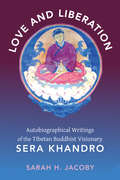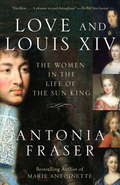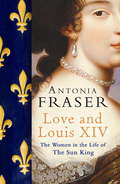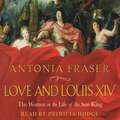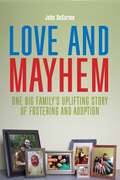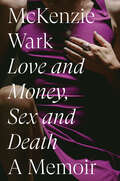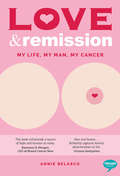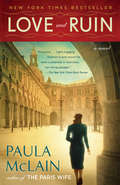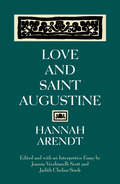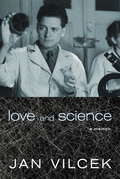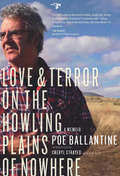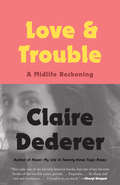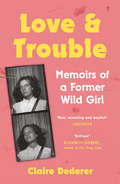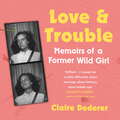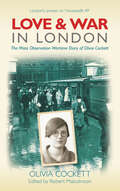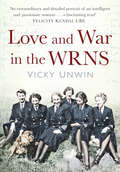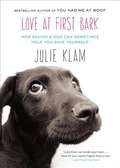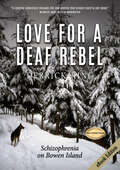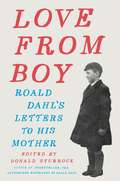- Table View
- List View
Love and Liberation: Autobiographical Writings of the Tibetan Buddhist Visionary Sera Khandro
by Sarah H. JacobySarah H. Jacoby is assistant professor in the Department of Religious Studies at Northwestern University. She is the coauthor of Buddhism: Introducing the Buddhist Experience and coeditor of Buddhism Beyond the Monastery: Tantric Practices and Their Performers in Tibet and the Himalayas.
Love and Liberation: Autobiographical Writings of the Tibetan Buddhist Visionary Sera Khandro
by Sarah JacobyLove and Liberation reads the autobiographical and biographical writings of one of the few Tibetan Buddhist women to record the story of her life. Sera Khandro Künzang Dekyong Chönyi Wangmo (also called Dewé Dorjé, 1892–1940) was extraordinary not only for achieving religious mastery as a Tibetan Buddhist visionary and guru to many lamas, monastics, and laity in the Golok region of eastern Tibet, but also for her candor. This book listens to Sera Khandro's conversations with land deities, dakinis, bodhisattvas, lamas, and fellow religious community members whose voices interweave with her own to narrate what is a story of both love between Sera Khandro and her guru, Drimé Özer, and spiritual liberation. Sarah H. Jacoby's analysis focuses on the status of the female body in Sera Khandro's texts, the virtue of celibacy versus the expediency of sexuality for religious purposes, and the difference between profane lust and sacred love between male and female tantric partners. Her findings add new dimensions to our understanding of Tibetan Buddhist consort practices, complicating standard scriptural presentations of male subject and female aide. Sera Khandro depicts herself and Drimé Özer as inseparable embodiments of insight and method that together form the Vajrayana Buddhist vision of complete buddhahood. By advancing this complementary sacred partnership, Sera Khandro carved a place for herself as a female virtuoso in the male-dominated sphere of early twentieth-century Tibetan religion.
Love and Louis XIV: The Women in the Life of the Sun King
by Antonia FraserLouis XIV, the highly-feted "Sun King", was renowned for his political and cultural influence and for raising France to a new level of prominence in seventeenth-century Europe. And yet, as Antonia Fraser keenly describes, he was equally legendary in the domestic sphere. Indeed, a panoply of women -- his wife Anne; mistresses such as Louise de la Vallière, Athénaïs de Montespan, and the puritanical Madame de Maintenon; and an array of courtesans -- moved in and out of the court. The highly visible presence of these women raises many questions about their position in both Louis XIV's life and in France at large. With careful research and vivid, engaging prose, Fraser makes the multifaceted life of one of the most famous European monarchs accessible and vibrantly current.From the Trade Paperback edition.
Love and Louis XIV: The Women in the Life of the Sun King
by Lady Antonia FraserMistresses and wives, mothers and daughters - Antonia Fraser brilliantly explores the relationships which existed between The Sun King and the women in his life. This includes not only Louis XIV's mistresses, principally Louise de La Vallière, Athénaïs de Montespan, and the puritanical Madame de Maintenon, but also the wider story of his relationships with women in general, including his mother Anne of Austria, his two sisters-in-law who were Duchesses d'Orléans in succession, Henriette-Anne and Liselotte, his wayward illegitimate daughters, and lastly Adelaide, the beloved child-wife of his grandson.
Love and Louis XIV: The Women in the Life of the Sun King
by Lady Antonia FraserMistresses and wives, mothers and daughters - Antonia Fraser brilliantly explores the relationships which existed between The Sun King and the women in his life. This includes not only Louis XIV's mistresses, principally Louise de La Vallière, Athénaïs de Montespan, and the puritanical Madame de Maintenon, but also the wider story of his relationships with women in general, including his mother Anne of Austria, his two sisters-in-law who were Duchesses d'Orléans in succession, Henriette-Anne and Liselotte, his wayward illegitimate daughters, and lastly Adelaide, the beloved child-wife of his grandson.Read by Patricia Hodge(p) 2006 Orion Publishing Group
Love and Mayhem: One Big Family's Uplifting Story of Fostering and Adoption
by John DegarmoMany people say being a parent is the toughest job there is. John DeGarmo, foster and adoptive parent, tells us just how tough it can be, having parented over 40 children. At times he and his wife, Kelly, have cared for up to nine children at a time, many with severe trauma and learning difficulties. Love and Mayhem is an honest and open account of the struggles, sadness and joy that comes with the job of being a parent to a traumatised child. From the sleepless nights with babies withdrawing from drug-addiction, to the heartbreak when a child moves on to another home, and the loving chaos that comes with a large and blended family, John DeGarmo fights for the many children who have come through his home. Ideal for foster families, general readers, fostering agencies and social workers who are looking for a true to life memoir of what it really is to be a foster parent.
Love and Money, Sex and Death
by McKenzie WarkA transgender woman reflects on her late transition and coming out, trans politics and culture, motherhood and memory, in this provocative epistolary memoir for readers of Olivia Laing&’s EverybodyA breathtaking memoir of transition, history, art, and memoryAfter a successful career, a twenty-year marriage, and two kids, McKenzie Wark has an acute midlife crisis: coming out as a trans woman. Changing both social role and bodily form recasts her relation to the world. Transition changes what, and how, she remembers. She makes fresh sense of her past and of history by writing to key figures in her life about the big themes that haunt us all—love and money, sex and death.In letters to her childhood self, her mother, sister, and past lovers, she writes a backstory that enables her to live in the present. The letters expand to address trans sisters lost and found, as well as Cybele, ancient goddess of trans women. She engages with the political, the aesthetic, and the numinous dimensions of trans life and how they refract her sense of who she is, who she has been, who she can still become. She confronts difficult memories that connect her mother&’s early death to her compulsion to write, her communist convictions, her coming to New York, the bittersweet reality of her late transition, and the joy to be found in Brooklyn&’s trans and raver communities.
Love and Need: The Life of Robert Frost’s Poetry
by Adam PlunkettBraiding together biography and criticism, Adam Plunkett challenges our understanding of Robert Frost’s life and poetic legacy in a pathbreaking new work.By the middle of the twentieth century, Robert Frost was the best-loved poet in America. He was our nation’s bard, simple and sincere, accompanying us on wooded roads and articulating our hopes and fears. After Frost’s death, these cliches gave way to equally broad (though opposed) portraits sketched by his biographers, chief among them Lawrance Thompson. When the critic Helen Vendler reviewed Thompson’s biography, she asked whether anyone could avoid the conclusion that Frost was a “monster.”In Love and Need: The Life of Robert Frost’s Poetry, Adam Plunkett blends biography and criticism to find the truth of Frost’s life—one that lies between the two poles of perception. Plunkett reveals a new Frost through a careful look at the poems and people he knew best, showing how the stories of his most important relationships,heretofore partly told, mirror dominant themes of Frost’s enduring poetry: withholding and disclosure, privacy and intimacy. Not least of these relationships is the fraught, intense friendship between Frost and Thompson, the major biographer whose record of Frost Plunkett seeks to set straight.Moving through Frost’s most important work and closest relationships with the attention to detail necessary to see familiar things anew, Plunkett offers an original interpretation of Frost’s poetry, tracing Frost’s distinctive achievement to an engagement with poetic tradition far deeper and more extensive than he ever let on. Frost invited his readers into a conversation like the one he sustained with his literary forebears, intimate and profound, yet Frost kept his private self at a remove. Here, Plunkett brings the two together—the poet and the poetry—and draws us back into conversation with America’s poet.
Love and Remission: My Life, My Man, My Cancer (Inspirational Series)
by Annie BelascoIn her mid-twenties, balancing a stable job and a partying lifestyle, Annie was also on the hunt for a man. She wanted to find Mr Right, get married, buy a house, and live the life she’d always wanted. But then one day, she found a lump ...Breast cancer. The two words that would derail Annie’s life. Suddenly she realised how short her life had been, and the very idea of finding love seemed impossible. As her hair fell out, and her social life crumbled, her mental health deteriorated. She began to question if she would actually survive. Struggling with an identity crisis and worryingly low moods, she wondered if she’d ever be able to live the normal life that had been within her reach only months earlier.Love and Remission tells the tale of a young woman in search of love and mental wellbeing.
Love and Ruin: A Novel
by Paula McLainNEW YORK TIMES BESTSELLER • A powerful novel of the stormy marriage between Ernest Hemingway and Martha Gellhorn, a fiercely independent woman who became one of the greatest war correspondents of the twentieth century—from the author of The Paris Wife and When the Stars Go Dark&“Romance, infidelity, war—Paula McLain&’s powerhouse novel has it all.&”—Glamour NAMED ONE OF THE BEST BOOKS OF THE YEAR BY The Washington Post • New York Public Library • Bloomberg • Real SimpleIn 1937, twenty-eight-year-old Martha Gellhorn travels alone to Madrid to report on the atrocities of the Spanish Civil War and becomes drawn to the stories of ordinary people caught in the devastating conflict. It&’s her chance to prove herself a worthy journalist in a field dominated by men. There she also finds herself unexpectedly—and unwillingly—falling in love with Ernest Hemingway, a man on his way to becoming a legend.On the eve of World War II, and set against the turbulent backdrops of Madrid and Cuba, Martha and Ernest&’s relationship and careers ignite. But when Ernest publishes the biggest literary success of his career, For Whom the Bell Tolls, they are no longer equals, and Martha must forge a path as her own woman and writer.Heralded by Ann Patchett as &“the new star of historical fiction,&” Paula McLain brings Gellhorn&’s story richly to life and captures her as a heroine for the ages: a woman who will risk absolutely everything to find her own voice.
Love and Saint Augustine
by Hannah ArendtA completely corrected and revised English translation that incorporates Arendt's own substantial revisions and provides additional notes based on letters, contracts, and other documents as well as the recollections of Arendt's friends and colleagues.
Love and Science: A Memoir
by Jan VilcekLong before he became one of the world's most celebrated immunologists, Jan Vilcek began life in Slovakia as the child of Jewish parents at a time when Jews were being exterminated all across Europe. He owes his and his mother’s survival to the courage of brave people and good luck. As a young man growing up in Czechoslovakia in the aftermath of the Second World War, Vilcek went to medical school and chose a career in virology and immunology at a time when these fields were still in their infancy. While still in his twenties he published a paper in the prestigious journal Nature, and he hosted the first international conference on interferon. Fleeing Communist Czechoslovakia with his wife Marica, Vilcek continued his research at NYU School of Medicine, going on to establish a highly successful career in biomedical research, and creating one of the most important and trailblazing medicines of our age. After his arrival in the US in 1965 as a penniless refugee, he soon went on to spearhead some of the key advances in the research of interferon that enabled its therapeutic application, and through his research into tumor necrosis factor (TNF) made advances that led to the discovery of new genes and proteins and signaling pathways, opening up previously uncharted areas of medical innovation that have led to important new treatments for a wide range of autoimmune and inflammatory diseases. Along the way Vilcek acquired material wealth he had never aspired to, catapulting him into the world of philanthropy. Love and Science shows how advances in science sometimes result from the greatest disappointments, and how achievement in medical research is usually a team effort, where ideas are shared, where friendship and love sometimes matter most and serendipity is as important as a will to succeed—and where, over time, the least expected thing sometimes becomes the most important. In Vilcek's case the vaunted cure for cancer that many saw in TNF never materialized. However, out of the ashes of that hope came many related treatments that have changed countless lives and alleviated much suffering.From the Hardcover edition.
Love and Spirit Medicine
by Shonagh HomeLove and Spirit Medicine chronicles the author's mystical journey through the end of her marriage and into a focused, shamanic exploration of entheogenic mushrooms. A love relationship unfolded during that time, sending her into a dark night of the soul Shonagh continued her shamanic explorations with the plant medicine, and discovered a well of resources. Using the mushrooms as a portal to the spirit worlds, Shonagh experienced a profound transformation of consciousness. She realized that the ceremonial use of sacred mushrooms offered a powerful path in her spiritual exploration. Each journey brought her into direct connection with the realms of the sacred. Through these journeys, she cultivated relationships with otherworldly beings that nourished her on a soul level. Through her desire to know Spirit and experience deep connection, she ultimately discovered her own divinity and her connection to the All "Ultimately, this is the story of my journey into Self. It became necessary for me to fall in love with the mystery of my own being. My experiences with the mushroom medicine have cultivated an intimate relationship with Mother Earth and a coterie of spirit beings. Through the use of sacred mushrooms, I have experienced an expansion of consciousness I never thought possible. It has deepened my sense of belonging within a vast universe of countless realms. This medicine is a potent portal into the world of the spirits," she writes in the introduction. Shonagh forms a unique relationship with the spirit world that has been made possible through her mushroom journeys. Like many traditional shamans through the ages, she finds herself to be a conduit for Spirit, thereby bringing through wisdom and guidance for herself and her community. She is eventually led into a very ancient practice as a "medicine oracle," and her life is forever changed Love and Spirit Medicine is an unusual love story; a tale that exemplifies what is possible through the reverent use of plant medicine for healing and transcendence on every level of our being. It's the story of a woman who ultimately discovers her journey is not about finding a soul mate, but coming to know and love her own soul.
Love and Terror on the Howling Plains of Nowhere
by Cheryl Strayed Poe BallantineFans of Truman Capote's In Cold Blood and John Berendt's Midnight in the Garden of Good and Evil will embrace Poe Ballantine's Love and Terror on the Howling Plains of Nowhere.For well over twenty years, Poe Ballantine traveled America, taking odd jobs, living in small rooms, and wondering the big whys. At age 46, he finally settled with his Mexican immigrant wife in Chadron, Nebraska, where they had a son who was red-flagged as autistic. Poe published four books about his experiences as a wanderer and his observations of America. But one day in 2006, his neighbor, Steven Haataja, a math professor from the local state college disappeared. Ninety five days later, the professor was found bound to a tree, burned to death in the hills behind the campus where he had taught. No one, law enforcement included, understood the circumstances. Poe had never contemplated writing mystery or true crime, but since he knew all the players, the suspects, the sheriff, the police involved, he and his kindergarten son set out to find out what might have happened.
Love and Trouble: A Midlife Reckoning
by Claire DedererFrom the New York Times best-selling author of Poser: My Life in Twenty-Three Yoga Poses, a ferocious, sexy, hilarious memoir about going off the rails at midlife and trying to reconcile the girl she was with the woman she has become. Claire Dederer is a happily married mother of two, ages nine and twelve, when she suddenly finds herself totally despondent and, simultaneously, suffering through a kind of erotic reawakening. This exuberant memoir shifts between her present experience as a middle-aged mom in the grip of mysterious new hungers and herself as a teenager--when she last experienced life with such heightened sensitivity and longing. From her hilarious chapter titles ("How to Have Sex with Your Husband of Seventeen Years") to her subjects--from the boyfriend she dumped at fourteen the moment she learned how to give herself an orgasm, to the girls who ruled her elite private school ("when I left Oberlin I thought I had done with them forever, but it turned out ...they also edited all the newspapers and magazines, and wrote all the books"), to raising a teenage daughter herself--Dederer writes with an electrifying blend of wry wit and raw honesty. She exposes herself utterly, and in doing so captures something universal about the experience of being a woman, a daughter, a wife.From the Hardcover edition.
Love and Trouble: A Midlife Reckoning
by Claire DedererA hilarious, confrontational and moving story of one woman's attempts to navigate her way through the challenges of mid-life, for lovers of HOW TO BE A WOMAN and I'M NOT WITH THE BAND. 'Claire Dederer is not only a brilliant author, but an honest and brave one' Elizabeth Gilbert, author of EAT, PRAY, LOVEClaire Dederer's youth was wild, an endless cascade of beer and rock and acid and sex that left her benumbed and adrift. But then, after two decades of disciplined transformation, she'd become a successful writer, a faithful wife, and a mother - a real adult. That is, until one morning at 44, she found herself overcome by the same sexual cravings and ineffable sadness of her younger years. The hedonistic girl, 'that crazy bitch', was back - or had she never left?Frank and disarming, seductive and hilarious, Love and Trouble: A Mid-life Reckoning is Dederer's attempt to reckon with those urges, and to reconcile the girl she'd been with the woman she's become.
Love and Trouble: Memoirs of a Former Wild Girl
by Claire DedererA hilarious, confrontational and moving story of one woman's attempts to navigate her way through the challenges of mid-life, for lovers of HOW TO BE A WOMAN and I'M NOT WITH THE BAND. 'Claire Dederer is not only a brilliant author, but an honest and brave one' Elizabeth Gilbert, author of EAT, PRAY, LOVEClaire Dederer's youth was wild, an endless cascade of beer and rock and acid and sex that left her benumbed and adrift. But then, after two decades of disciplined transformation, she'd become a successful writer, a faithful wife, and a mother - a real adult. That is, until one morning at 44, she found herself overcome by the same sexual cravings and ineffable sadness of her younger years. The hedonistic girl, 'that crazy bitch', was back - or had she never left?Frank and disarming, seductive and hilarious, Love and Trouble: A Mid-life Reckoning is Dederer's attempt to reckon with those urges, and to reconcile the girl she'd been with the woman she's become.(P)2017 Penguin Random House LLC
Love and War in London: The Mass Observation Wartime Diary of Olivia Cockett
by Robert Malcolmson Olivia CockettLove & War in London is rooted in the extraordinary milieu of wartime London. Vibrant and engaging, Olivia Cockett’s diary reveals her frustrations, fears, pleasures and self-doubts. She recorded her mood swings and tried to understand them, and wrote of her lover (a married man) and the intense relationship they had. As she and her friends and family in New Scotland Yard were swept up by the momentous events of another European war, she vividly reported on what she saw and heard in her daily life. Hers is a diary that brings together the personal and the public. It permits us to understand how one intelligent, imaginative woman struggled to make sense of her life, as the city in which she lived was drawn into the turmoil of a catastrophic war.
Love and War in the WRNS: Letters Home 1940-46
by Vicky UnwinSheila Mills’s story is a unique perspective of the Second World War. She is a clever, middle-class Norfolk girl with a yen for adventure and joins the WRNS in 1940 to escape the shackles of secretarial work in London, her unhappy childhood and her social-climbing mother. From a first posting in Scotland in 1940, she progresses through the ranks, first to Egypt and later to a vanquished Germany.Extraordinary and fascinating encounters and personalities are seen through the eyes of a young Wren officer: Admiral Ramsay, the Invasion of Sicily and Operation Mincemeat that triggered it, The Flap, the sinking of the Medway, the surrender of the Italian fleet and the Belsen Trials. These observations are peppered with humorous insights into the humdrum preoccupations of a typical Wren – boys, appearance and having fun, while worrying about home and family.This treasure trove of hundreds of letters, along with scrapbooks and memorabilia, some of which are reproduced here, was discovered in bin liners shortly after Sheila died. Her daughter, Vicky, has pieced together a fascinating and unusual record of the Second World War from a woman’s perspective.
Love as Always, Mum xxx: The true and terrible story of surviving a childhood with Fred and Rose West
by Mae West'A CHILLING new memoir by the daughter of mass murderer Fred West and his wife Rose describes the savage cruelty of her upbringing in 25 Cromwell Street, Gloucester' DAILY MAIL'Mae, I mean this ... I'm not a good person and I let all you children down ...' Rose West, HM PRISON DURHAM It has taken over 20 years for Mae West to find the perspective and strength to tell her remarkable story: one of an abusive, violent childhood, of her serial killer parents and how she has rebuilt her life in the shadow of their terrible crimes. Through her own memories, research and the letters her mother wrote to her from prison, Mae shares her emotionally powerful account of her life as a West. From a toddler locked in the deathly basement to a teen fighting off the sexual advances of her father, Mae's story is one of survival. It also answers the questions: how do you come to terms with knowing your childhood bedroom was a graveyard? How do you accept the fact your parents sexually tortured, murdered and dismembered young women? How do you become a mother yourself when you're haunted by the knowledge that your own mother was a monster? Why were you spared and how do you escape the nightmare?
Love as Always, Mum xxx: The true and terrible story of surviving a childhood with Fred and Rose West
by Mae West'A CHILLING new memoir by the daughter of mass murderer Fred West and his wife Rose describes the savage cruelty of her upbringing in 25 Cromwell Street, Gloucester' DAILY MAIL'Mae, I mean this ... I'm not a good person and I let all you children down ...' Rose West, HM PRISON DURHAM It has taken over 20 years for Mae West to find the perspective and strength to tell her remarkable story: one of an abusive, violent childhood, of her serial killer parents and how she has rebuilt her life in the shadow of their terrible crimes. Through her own memories, research and the letters her mother wrote to her from prison, Mae shares her emotionally powerful account of her life as a West. From a toddler locked in the deathly basement to a teen fighting off the sexual advances of her father, Mae's story is one of survival. It also answers the questions: how do you come to terms with knowing your childhood bedroom was a graveyard? How do you accept the fact your parents sexually tortured, murdered and dismembered young women? How do you become a mother yourself when you're haunted by the knowledge that your own mother was a monster? Why were you spared and how do you escape the nightmare?What other readers are saying about Love as Always, Mum xxx:'A fascinating read. Mae West seems like such a warmhearted and caring person. It was heart-breaking to hear about what she went through.' 5* Goodreads'This book is truly moving in many ways and as much as I want to say I enjoyed it, I didn't, because it was heart-wrenching, but that's why it's a 5-star read. So much emotion and truth. It's definitely hard not to be moved by this.' 5* Goodreads'This is an extremely important story to read, giving Mae a voice to be verbal about breaking the cycle of abuse and surviving a terror she never thought she would be a part of. And because of that, it deserves five stars.' 5* Goodreads'This has got to be the most heartbreaking and emotionally demanding book I have ever read ... a heart wrenching and powerful read.' 5* Goodreads'As an avid reader of true crime books I had read a lot about Feed and Rose West. However with all of those books I had never considered their surviving children. This feels like such a raw, honest and real account of day to day life in 25 Cromwell Street. Good on you Mae for your strength to tell your story.' 5* Goodreads'A hauntingly tragic book. I couldn't put it down from start to finish.' 5* Goodreads
Love at First Bark
by Julie KlamIn her bestselling memoir You Had Me at Woof, Julie Klam shared the secrets of happiness she learned as an occasionally frazzled but always devoted owner of Boston terriers. Now, with the same enchanting humor and poignancy that won the hearts of readers across the country, she returns with real-life stories about how in rescuing troubled dogs we can end up saving ourselves. With wit and warmth, Julie Klam chronicles her adventures in finding a home for the world’s sweetest pit bull, fostering a photogenic special-needs terrier, and diving under a train to save an injured stray in New Orleans. Along the way, she finds that helping dogs in their fight to survive puts our own problems in perspective, and shows that caring for others, be they canine or human, can sometimes be the best way to care for ourselves. A hilarious and moving testament to the powerful bond between people and dogs, this is a book for anyone whose life has been changed—for the better—by an animal. .
Love for a Deaf Rebel: Schizophrenia On Bowen Island
by Derrick KingLove for a Deaf Rebel is the true story of a tumultuous romance. <P><P> With pathos and nostalgia, the author recounts his roller-coaster ride with Pearl, a vivacious deaf maverick, who, unknown to him, had paranoid schizophrenia. <P><P> We follow their encounters through actual notes written before Derrick learns sign language; we go on their motorcycle ride to Mexico and Guatemala; we watch as the happy couple moves to Bowen Island, a British Columbia community with just three paved roads. <P><P> Pearl and the author marry and build their dream home and hobby farm. They encounter one obstacle after another while building their life together as Pearl's perception of reality-and, crucially, their perception of each other-begins to change. <P><P> The author learns what it means to be deaf, what it means to struggle with mental health, and what it means to love such a woman unconditionally-the ecstasy and the agony. <P><P> A love story and memoir that touches on deafness, schizophrenia, and roughing it in isolated British Columbia.
Love from Boy: Roald Dahl's Letters to His Mother
by Donald SturrockFrom the author of The BFG--soon to be a major motion picture directed by Steven Spielberg and starring Mark Rylance, Ruby Barnhill, Penelope Wilton, Jemaine Clement, Bill Hader, and Adam Godley--a whimsical, witty, and revealing collection of the legendary children's author and writer Roald Dahl's letters written to his mother, from early childhood through Dahl's travels to Africa, his career in the Royal Air Force, his work in post-war Washington, D.C., and Hollywood, and the books that made him a literary star. Roald Dahl penned his first letter to his mother, Sofie Magdalene, when he was just nine years old. The origins of a brilliantly funny, subversive, creative mind were evident in boarding school, and as he entered adulthood, his penchant for storytelling emerged in his missives home from Africa, where he was stationed by Shell Oil, and then the desert camps of the Royal Air Force. His skills were sharpened after a plane crash in Egypt landed him in Washington, D.C., where his cheery letters home were cover for his work in the British Secret Service, along with gossipy updates on his spontaneous rise in Hollywood and his budding New York literary career. His mother was, in many ways, Dahl's first reader, and without her correspondence he might never have become a writer. Sofie Magdalene kept every letter her son wrote to her (sadly, her own side of the correspondence did not survive). It was she who encouraged him to tell stories and nourished his desire to fabricate, exaggerate, and entertain. In these letters, Dahl began practicing his craft, developing the dark sense of humor and fantastical imagination that would later produce his timeless tales. The author of James and the Giant Peach, Charlie and the Chocolate Factory, Matilda, and The BFG, Dahl is known by millions the world over today. But, writing candidly to the person who knew him best, Dahl was as singular a character as any he created on paper. Assembled by Dahl's authorized biographer Donald Sturrock, Love from Boy is a remarkable collection of never-before-published writing that spans four decades and chronicles the remarkable, unpredictable life of its author. While Dahl's books remain bestselling favorites for all ages, Love from Boy provides an unprecedented glimpse of the author through his own eyes--a life punctuated by tragedy, creative stagnation, unexpected fame, and fantastic adventure.From the Hardcover edition.
Love from Boy: Roald Dahl's Letters to His Mother
by Donald SturrockFrom the author of The BFG, Matilda, James and the Giant Peach, Willy Wonka and the Chocolate Factory, and many more beloved classics--a whimsical, witty, and revealing collection of the legendary children's author and writer Roald Dahl's letters written to his mother, from early childhood through Dahl's travels to Africa, his career in the Royal Air Force, his work in post-war Washington, D.C., and Hollywood, and the books that made him a literary star. Roald Dahl penned his first letter to his mother, Sofie Magdalene, when he was just nine years old. The origins of a brilliantly funny, subversive, creative mind were evident in boarding school, and as he entered adulthood, his penchant for storytelling emerged in his missives home from Africa, where he was stationed by Shell Oil, and then the desert camps of the Royal Air Force. His skills were sharpened after a plane crash in Egypt landed him in Washington, D.C., where his cheery letters home were cover for his work in the British Secret Service, along with gossipy updates on his spontaneous rise in Hollywood and his budding New York literary career. His mother was, in many ways, Dahl's first reader, and without her correspondence he might never have become a writer. Sofie Magdalene kept every letter her son wrote to her (sadly, her own side of the correspondence did not survive). It was she who encouraged him to tell stories and nourished his desire to fabricate, exaggerate, and entertain. In these letters, Dahl began practicing his craft, developing the dark sense of humor and fantastical imagination that would later produce his timeless tales. The author of James and the Giant Peach, Charlie and the Chocolate Factory, Matilda, and The BFG, Dahl is known by millions the world over today. But, writing candidly to the person who knew him best, Dahl was as singular a character as any he created on paper. Assembled by Dahl's authorized biographer Donald Sturrock, Love from Boy is a remarkable collection of never-before-published writing that spans four decades and chronicles the remarkable, unpredictable life of its author. While Dahl's books remain bestselling favorites for all ages, Love from Boy provides an unprecedented glimpse of the author through his own eyes--a life punctuated by tragedy, creative stagnation, unexpected fame, and fantastic adventure.From the Hardcover edition.
